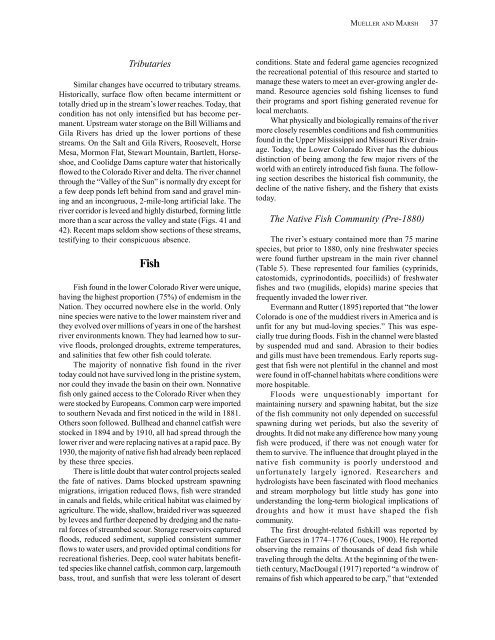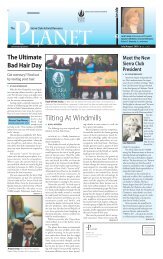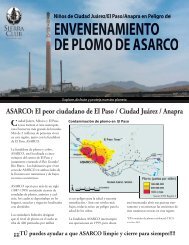Lost, A Desert River and its Native Fishes - Sierra Club
Lost, A Desert River and its Native Fishes - Sierra Club
Lost, A Desert River and its Native Fishes - Sierra Club
Create successful ePaper yourself
Turn your PDF publications into a flip-book with our unique Google optimized e-Paper software.
Tributaries<br />
Similar changes have occurred to tributary streams.<br />
Historically, surface flow often became intermittent or<br />
totally dried up in the stream‘s lower reaches. Today, that<br />
condition has not only intensified but has become permanent.<br />
Upstream water storage on the Bill Williams <strong>and</strong><br />
Gila <strong>River</strong>s has dried up the lower portions of these<br />
streams. On the Salt <strong>and</strong> Gila <strong>River</strong>s, Roosevelt, Horse<br />
Mesa, Mormon Flat, Stewart Mountain, Bartlett, Horseshoe,<br />
<strong>and</strong> Coolidge Dams capture water that historically<br />
flowed to the Colorado <strong>River</strong> <strong>and</strong> delta. The river channel<br />
through the —Valley of the Sun“ is normally dry except for<br />
a few deep ponds left behind from s<strong>and</strong> <strong>and</strong> gravel mining<br />
<strong>and</strong> an incongruous, 2-mile-long artificial lake. The<br />
river corridor is leveed <strong>and</strong> highly disturbed, forming little<br />
more than a scar across the valley <strong>and</strong> state (Figs. 41 <strong>and</strong><br />
42). Recent maps seldom show sections of these streams,<br />
testifying to their conspicuous absence.<br />
Fish<br />
Fish found in the lower Colorado <strong>River</strong> were unique,<br />
having the highest proportion (75%) of endemism in the<br />
Nation. They occurred nowhere else in the world. Only<br />
nine species were native to the lower mainstem river <strong>and</strong><br />
they evolved over millions of years in one of the harshest<br />
river environments known. They had learned how to survive<br />
floods, prolonged droughts, extreme temperatures,<br />
<strong>and</strong> salinities that few other fish could tolerate.<br />
The majority of nonnative fish found in the river<br />
today could not have survived long in the pristine system,<br />
nor could they invade the basin on their own. Nonnative<br />
fish only gained access to the Colorado <strong>River</strong> when they<br />
were stocked by Europeans. Common carp were imported<br />
to southern Nevada <strong>and</strong> first noticed in the wild in 1881.<br />
Others soon followed. Bullhead <strong>and</strong> channel catfish were<br />
stocked in 1894 <strong>and</strong> by 1910, all had spread through the<br />
lower river <strong>and</strong> were replacing natives at a rapid pace. By<br />
1930, the majority of native fish had already been replaced<br />
by these three species.<br />
There is little doubt that water control projects sealed<br />
the fate of natives. Dams blocked upstream spawning<br />
migrations, irrigation reduced flows, fish were str<strong>and</strong>ed<br />
in canals <strong>and</strong> fields, while critical habitat was claimed by<br />
agriculture. The wide, shallow, braided river was squeezed<br />
by levees <strong>and</strong> further deepened by dredging <strong>and</strong> the natural<br />
forces of streambed scour. Storage reservoirs captured<br />
floods, reduced sediment, supplied consistent summer<br />
flows to water users, <strong>and</strong> provided optimal conditions for<br />
recreational fisheries. Deep, cool water habitats benefitted<br />
species like channel catfish, common carp, largemouth<br />
bass, trout, <strong>and</strong> sunfish that were less tolerant of desert<br />
MUELLER AND MARSH 37<br />
conditions. State <strong>and</strong> federal game agencies recognized<br />
the recreational potential of this resource <strong>and</strong> started to<br />
manage these waters to meet an ever-growing angler dem<strong>and</strong>.<br />
Resource agencies sold fishing licenses to fund<br />
their programs <strong>and</strong> sport fishing generated revenue for<br />
local merchants.<br />
What physically <strong>and</strong> biologically remains of the river<br />
more closely resembles conditions <strong>and</strong> fish communities<br />
found in the Upper Mississippi <strong>and</strong> Missouri <strong>River</strong> drainage.<br />
Today, the Lower Colorado <strong>River</strong> has the dubious<br />
distinction of being among the few major rivers of the<br />
world with an entirely introduced fish fauna. The following<br />
section describes the historical fish community, the<br />
decline of the native fishery, <strong>and</strong> the fishery that exists<br />
today.<br />
The <strong>Native</strong> Fish Community (Pre-1880)<br />
The river‘s estuary contained more than 75 marine<br />
species, but prior to 1880, only nine freshwater species<br />
were found further upstream in the main river channel<br />
(Table 5). These represented four families (cyprinids,<br />
catostomids, cyprinodontids, poeciliids) of freshwater<br />
fishes <strong>and</strong> two (mugilids, elopids) marine species that<br />
frequently invaded the lower river.<br />
Evermann <strong>and</strong> Rutter (1895) reported that —the lower<br />
Colorado is one of the muddiest rivers in America <strong>and</strong> is<br />
unfit for any but mud-loving species.“ This was especially<br />
true during floods. Fish in the channel were blasted<br />
by suspended mud <strong>and</strong> s<strong>and</strong>. Abrasion to their bodies<br />
<strong>and</strong> gills must have been tremendous. Early reports suggest<br />
that fish were not plentiful in the channel <strong>and</strong> most<br />
were found in off-channel habitats where conditions were<br />
more hospitable.<br />
Floods were unquestionably important for<br />
maintaining nursery <strong>and</strong> spawning habitat, but the size<br />
of the fish community not only depended on successful<br />
spawning during wet periods, but also the severity of<br />
droughts. It did not make any difference how many young<br />
fish were produced, if there was not enough water for<br />
them to survive. The influence that drought played in the<br />
native fish community is poorly understood <strong>and</strong><br />
unfortunately largely ignored. Researchers <strong>and</strong><br />
hydrologists have been fascinated with flood mechanics<br />
<strong>and</strong> stream morphology but little study has gone into<br />
underst<strong>and</strong>ing the long-term biological implications of<br />
droughts <strong>and</strong> how it must have shaped the fish<br />
community.<br />
The first drought-related fishkill was reported by<br />
Father Garces in 1774œ1776 (Coues, 1900). He reported<br />
observing the remains of thous<strong>and</strong>s of dead fish while<br />
traveling through the delta. At the beginning of the twentieth<br />
century, MacDougal (1917) reported —a windrow of<br />
remains of fish which appeared to be carp,“ that —extended














